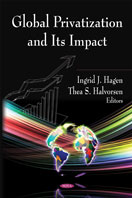Authors: Ingrid J. Hagen and Thea S. Halvorsen
Nova Publishers 2009
Chapter 7 title: Quantitative analysis of privatization
Authors: Mahsa Vahabi, G. Reza Jafari
Book Description:
In recent years, the economic policy of privatization, which is defined as the transfer of property or responsibility from public sector to private sector, is one of the global phenomenon that increases use of markets to allocate resources. One important motivation for privatization is to help develop factor and product markets, as well as security markets. Progress in privatization is correlated with improvements in perceived political and investment risk. Many emerging countries have gradually reduced their political risks during the course of sustained privatization. In fact, most
risk resolution seems to take place as privatization proceeds to its later stage. Alternative benefits of privatization are improved risk
sharing and increased liquidity and activity of the market. One of the main methods to develop privatization is entering a new stock to the markets for arising competition. This book provides leading edge research on this field from around the globe
Chapter 7 title: Quantitative analysis of privatization
Authors: Mahsa Vahabi, G. Reza Jafari
Abstract of Chapter:
In recent years, the economic policy of privatization, which is defined as the transfer of property or responsibility from public sector to private sector, is one of the global phenomenon that increases use of markets to allocate resources. One important motivation for privatization is to help develop factor and product markets, as well as security markets. Progress in privatization is correlated with improvements in perceived political and investment risk. Many emerging countries have gradually reduced their political risks during the course of sustained privatization. In fact, most risk resolution seems to take place as privatization proceeds to its later stage. Alternative benefits of privatization are improved risk sharing and increased liquidity and activity of the market. One of the main methods to develop privatization is entering a new stock to the markets for arising competition. However, attention to the capability of the markets to accept a new stock is substantial. Without considering the above statement, it is possible to reduce the market’s efficiency. In other words, introduction of a new stock to the market usually decreases the stage of development and activity and increases the risk. Based on complexity theory, we quantify how the following factors: stage of development, activity, risk and investment horizons play roles in the privatization.
Table of Contents:
Preface
1. Healthcare’s Unhealthy Association with the Marketplace
(Colchester General Hospital, Colchester, Essex, UK) pp. 1-25
2. Privatization, Competition and Performance: Evidence from Australia
(Isaac Otchere, Sprott School of Business, Carleton University, Ottawa Canada) pp. 27-45
3. Privatization, Land Market and Land Use Conversion in China
(K.W. Chau, Department of Real Estate and Construction University of Hong Kong, Winky K.O. Ho, Department of Real Estate and Construction University of Hong Kong) pp. 47-59
4. Privatization as a Strategy of Restructuring in Developing Economies: The Case of Turkey
(Recep KÖK, Department of Economics, Dokux Eylül University, Izmir, Orhan COBAN, Department of Economics, Selcuk University, Konya, Turkey) pp. 61-85
5. Global Privatization in Energy Sectors: Global “Primitive Accumulation”
(Serdal Bahçe, Faculty of Political Sciences, Ankara University) pp. 87-101
6. Who Shall own the Genes of Farmed Fish?
(Ingrid Olesen, Hans B. Bentsen, Nofima AKVAFORS-Fiskeriforskning, Kristin Rosendal, The Fridtjof Nansen Institute, Morten Rye, Akvaforsk Genetics Center, Norway) pp. 103-113
7. Quantitative Analysis of Privatization
(M. Vahabi, G.R. Jafari, Department of Physics, Shahid Beheshti University, Tehran, Iran) pp. 115-134
Edited By Behzad Ghanbarian, Allen G. Hunt
Pub. location Boca Raton
Imprint CRC Press
Pages: 364 pages
eBook ISBN 9781498748728
Subjects Earth Sciences, Mathematics & Statistics
Authors: Gholamreza Jafari, Soheil Vasheghani Farahani, Zahra Koohi Lai, Seyed Mohammad Sadegh Movahed
Features
- Introduces basic concepts of fractal geometry
- Provides broad applications of fractals and multifractals
- Provides recent developments and progresses
- Unifies modern techniques proposed recently in the literature
Summary
This book provides theoretical concepts and applications of fractals and multifractals to a broad range of audiences from various scientific communities, such as petroleum, chemical, civil and environmental engineering, atmospheric research, and hydrology. In the first chapter, we introduce fractals and multifractals from physics and math viewpoints. We then discuss theory and practical applications in detail. In what follows, in chapter 2, fragmentation process is modeled using fractals. Fragmentation is the breaking of aggregates into smaller pieces or fragments, a typical phenomenon in nature. In chapter 3, the advantages and disadvantages of two- and three-phase fractal models are discussed in detail. These two kinds of approach have been widely applied in the literature to model different characteristics of natural phenomena. In chapter 4, two- and three-phase fractal techniques are used to develop capillary pressure curve models, which characterize pore-size distribution of porous media. Percolation theory provides a theoretical framework to model flow and transport in disordered networks and systems. Therefore, following chapter 4, in chapter 5 the fractal basis of percolation theory and its applications in surface and subsurface hydrology are discussed. In chapter 6, fracture networks are shown to be modeled using fractal approaches. Chapter 7 provides different applications of fractals and multifractals to petrophysics and relevant area in petroleum engineering. In chapter 8, we introduce the practical advantages of fractals and multifractals in geostatistics at large scales, which have broad applications in stochastic hydrology and hydrogeology. Multifractals have been also widely applied to model atmospheric characteristics, such as precipitation, temperature, and cloud shape. In chapter 9, these kinds of properties are addressed using multifractals. At watershed scales, river networks have been shown to follow fractal behavior. Therefore, the applications of fractals are addressed in chapter 10. Time series analysis has been under investigations for several decades in physics, hydrology, atmospheric research, civil engineering, and water resources. In chapter 11, we therefore, provide fractal, multifractal, multifractal detrended fluctuation analyses, which can be used to study temporal characterization of a phenomenon, such as flow discharge at a specific location of a river. Chapter 12 addresses signals and again time series using a novel fractal Fourier analysis. In chapter 13, we discuss constructal theory, which has a perspective opposite to fractal theories, and is based on optimization of diffusive exchange. In the case of river drainages, for example, the constructal approach begins at the divide and generates headwater streams first, rather than starting from the fundamental drainage pattern.
Chapter 10 Multi-fractal Random Walk and Its Application in Petro-physical Quantities
Authors: Gholamreza Jafari, Soheil Vasheghani Farahani, Zahra Koohi Lai, Seyed Mohammad Sadegh Movahed
Abstract: In order to produce an increase in the oil and gas production from rock reservoirs, it is essential to study the geological structure of large-scale porous media, which are at some length scales highly heterogeneous. In addition, further studying and modeling porous media requires investigating the flow of unwanted industrial constituents (known as leakage) in groundwater and accordingly capturing the distribution of the petrophysical characteristics (e.g., permeability) in the porous media. However, due to the lack of sufficient data and their non-stationary characteristics, the results obtained by most models are vague. The reason that the data is non-stationary is that of the fluctuations of the data over the long length-scale. Note that in characterizing laboratory-scale data this problem is not faced (Muller 1992, Adler 1992, Adler 1999, Sahimi 1993).
 Book title: Global Privatization and Its Impact
Book title: Global Privatization and Its Impact